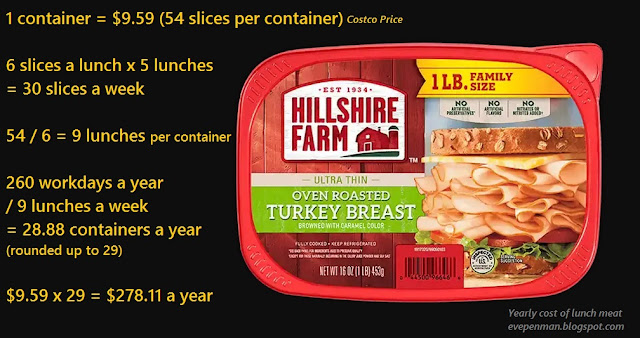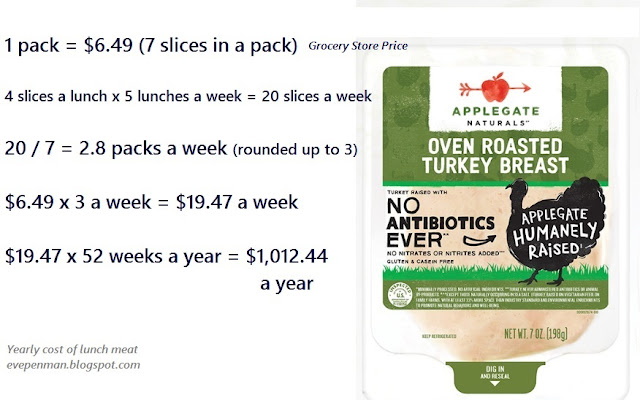 Q: What’s the best way to save money when shopping at Costco?
Q: What’s the best way to save money when shopping at Costco?A: Buy items that are used every day!
The more an item is used, the more that item is needed; therefore, if the most used items in a house are bought in bulk (at Costco or any warehouse club store), the more money it will save.
I did a cost analysis on three food items that are used 5 to 7 days a week in my home and I was amazed at the findings when I compared the cost for the items in bulk to purchasing the items in smaller quantities; namely lunch cheese, coffee, and lunch meat.
Please keep in mind that prices can vary by location and if there are weekly specials; the information I’m presenting is based on the prices listed on my receipts where I live, the Olympic Peninsula in Washington State.
Lunch Cheese:
In December of 2019 we started purchasing the 2.5lb block of Tillamook Pepper Jack Cheese at Costco for my husband’s lunches that he has five days a week, instead of the 7.5oz packages of sliced Sargento Cheese at the grocery store; now that it is April of 2020, the block of Tillamook purchased in December is almost used up and has lasted us 18 weeks, which gives me the number I needed to calculate the cost difference for one year:
52 weeks in a year divided by the 18 weeks it takes to go through one block of cheese equals 2.88; but since we can’t buy 2.88 blocks of cheese, it will be 3 blocks of cheese needed for the year.
The cost of the cheese at Costco is $7.99, times 3 blocks of cheese for the year equals $23.97; so that is the cost of one year’s worth of lunch cheese at Costco, $23.97.
Now for comparing it to the Sargento Cheese from the grocery store (I’m not bashing any brands, just presenting the information):
The 7.5oz pack of cheese would last two work weeks (10 slices at one slice a day), and one pack of cheese costs $3.99.
52 weeks in a year divided by the 2 weeks it took to go through one pack of cheese equals 26; so, we would have to buy 26 packs of cheese for the year.
At a cost of $3.99 a pack, times 26 packs of cheese would equal a yearly cost of $103.74, just for lunch cheese alone!
Now, the difference between the $103.74 yearly price at the grocery store, and the $23.97 yearly price at Costco is $79.77, which may not sound like much in a year, but that price difference is almost what we spend on coffee in an entire year, which we now buy in bulk at Costco too.
Coffee:
Before buying coffee beans in bulk at Costco, we would buy ground coffee at the grocery store; since my husband is the coffee drinker he picks out what he likes and the brand would always vary; but based on receipts I reviewed from August of 2019 through December of 2019, we spent $82.82 on coffee in those five months.
We started buying coffee beans in bulk at Costco in January of this year (2020); at first we were buying SF Bay French Roast Coffee, but this last week Costco had a different brand at the same price.
A 2-pound bag costs $9.99 and has been lasting 46 to 47 days; however, my husband recently increased his daily coffee consumption from 9 cups to 12 cups now that he’s at home more, and the 46/47-day average doesn’t reflect the new increase which is temporary anyway, since he’s only drinking more while on the forced break from work due to the Coronavirus issue.

So, for a high-end estimate, the most coffee we will buy in one year is 10 bags; and 365 days a year divided by 10 bags a year means one bag would last 36.5 days.
10 bags of coffee a year, times $9.99 would cost $99.90 for the whole year, which is much better than $82.82 that was spent on coffee at the grocery store in only five months; this isn’t including what is spent on other items that go into the coffee (creamer, etc.) so the $99.90 is only for the coffee beans, but that is the most important part of coffee, isn’t it?
When my husband returns to work the coffee consumption will go down again, so it’s likely to be 8 or 9 bags of coffee for the year, which would be a yearly cost between $80 and $90.
$100 a year on coffee beans isn’t too bad when you consider that spending $5 on coffee 20 times at a coffee shop would equal $100 -- and $100 is more than one-third of what we are now spending on lunch meat for a whole year!
Lunch Meat:
Just like with the lunch cheese, we started buying lunch meat in bulk at Costco in December of 2019, the Hillshire Farm brand, instead of buying it in smaller quantities at the grocery store; we usually bought different brands based on quality and Applegate was the last brand we purchased based on the quality, but no matter the brand the price didn’t differ much for high quality turkey meat.
The Hillshire Farm turkey from Costco costs $9.59 a container and comes with 54 slices in each container; I use 6 slices at a time, so one container makes 9 lunches.
With 260 workdays in a year, divided by 9 lunches per container, I would need 28.88 containers of turkey from Costco for one year; but it would need to be 29 containers since I can’t buy 28.88.
So, 29 containers of turkey at a cost of $9.59 each would equal $278.11 for one year’s worth of lunch meat from Costco; divided by 12 months it breaks down to $23.18 a month for lunch meat.
Now to show where the biggest savings are since we’ve stopped buying lunch meat at the grocery store:
The lunch meat we were buying came with 7 slices in a package, and since the meat was thicker I only used 4 slices at a time in each lunch; at 5 lunches a week times 4 slices in each lunch, it took 20 slices to get through one week of lunches; with 7 slices in each pack, it equals 2.8 packs of lunch meat a week, but it has to be rounded up to 3 packs of lunch meat for one week otherwise there isn’t enough.
The lunch meat prices would vary depending on weekly specials at the grocery store, but $6.49 was the regular price; so, at a price of $6.49 and having to buy 3 packs a week, it was costing us $19.47 a week for lunch meat.
Now for the kicker -- at 52 weeks a year and a cost of $19.47 for lunch meat each week, it would have cost us $1,012.44 for lunch meat just for one year! And what we were paying for one week of lunch meat from the grocery store ($19.47) is only a few dollars less than what we are now paying for one month of lunch meat from Costco ($23.18)!
The cost difference between what we would have spent at the grocery store on lunch meat for a year, $1,012.44, minus what we are now spending at Costco in a year, $278.11, is a difference of $734.33 -- and that’s more than what our new furnace cost!
Isn’t home economics fascinating?! It is when it saves money!
Small changes in groceries can make a big difference over time, and my numbers prove how valuable and economical shopping in bulk at Costco has been for us since making small changes in the past few months; the key, of course, is to buy items we use every day, or at least 5 days a week.
Buying food that doesn’t get used and expires is not the best way to save money, even if it is on sale which sometimes means it will expire sooner than later; food must get used before it expires in order to get value out of it.
Even if expired food isn’t always a waste of money, it is always a waste of food resources, and with the recent Coronavirus issues in America and lack of food in stores, I’m guessing that many people are learning the importance of being resourceful with food rather than wasteful, myself included.
Quality is always an issue to us and it’s different for everyone, but what matters most in our home is that the food doesn’t upset our digestion, especially my husband’s since the last thing he needs when working is an upset stomach; all of the products we have started buying at Costco haven’t caused any digestive problems, and what’s even better is that my husband likes the flavor of the Tillamook Cheese more than what we were buying in the grocery store.
It’s true that shopping at Costco does require a membership, but the savings more than make up for the yearly membership cost, which is currently $60 for the basic Gold Star Membership (no affiliation, just information); thanks to my husband’s work they include a Costco membership as an employee perk, and such a valuable perk it is that we aren’t letting it go to waste!
A few other helpful hints about how to save money when shopping at Costco:
- Write a list and stick to it; I'll write more about this in a future post.
- Don't buy items that you don't plan to use just because it's a good price.
- Don't buy more than you need;
- a 36-pack of toilet paper lasts us two to three months for two adults, which tells me that the people who are panicked into buying more toilet paper than they can use in a year aren't keeping track of their spending or what they use in their own home.
I fully understand that more money could be saved if we just ate beans and rice as is suggested by some financial gurus; however, we want to enjoy our daily lives with foods that make us feel good and make life better.
Even if eating beans and rice seven days a week saved us money, it wouldn't help our mental outlook when it comes to getting through our current situation as a single-income blue collar household; it's one thing to make $60k or $80k/year and have to cut back; it's another thing to make less than $35k/year and be at the top earning range to qualify for a Habitat for Humanity house -- that's depressing enough without adding beans and rice on top of it!!!
That's why both my husband and I continue to change our food preferences in small ways for the sake of the budget, and I continue to work at figuring out what else we can buy at Costco in bulk to save money; and it is working, because we have money in emergency savings and money in our checking account; we no longer spend an entire paycheck in a pay period, and we aren't having to survive on beans and rice to make it happen.
I hope this post helps readers see the value of shopping in bulk for items that are used every day, whether they're purchased at Costco or another warehouse club store; please leave any questions, remarks, or math corrections in the comments.
Thanks for reading!



